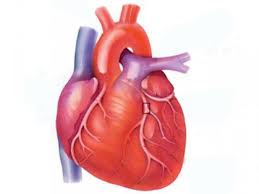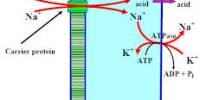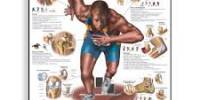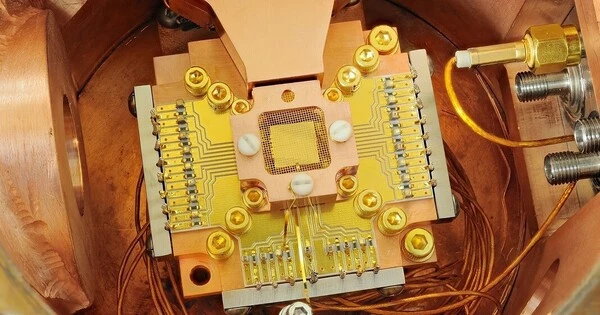A.1 PRELIMINARY STUDY
This phase is mainly about the analysis of the current manual system. I investigated the whole manual system to understand what is actually done. All the processing steps including information gathering, processing and information retrieval system were carefully analysed. The steps taken for the accomplishment of this analysis are just pointed below:
ANALYSIS OF VARIOUS MANUAL REGISTER BOOKS:
Various books like PATIENTS INFORMATION BOOK, FEE COLLECTION BOOK, ACCOUNTS BOOK, MAINTENANCE BOOK etc were carefully studied and the main ways of storing information were investigated.
ANALYSIS OF OUTPUTS SUCH AS RECEIPTS AND REPORTS:
All the outputs were studied for understanding the information required to produce the outputs and the information contained in the outputs.
VISITING THE ACCOUNTS DEPARTMENT AND OBSERVING THE TRANSACTIONS:
- I stood beside the cashier and watched what he did to serve the patients and staffs, meaning how the different receipts were produced and the different details about each transaction written in the related files.
INTERVIEW WITH THE MANAGING DIRECTOR, ACCOUNTS OFFICER AND VARIOUS EMPLOYEES:
- The subject of the interview was focused on various parts of the manual system. [The transcript is given in section-A]
SORTING THE PROBLEMS WITH THE MANUAL SYSTEM:
- The Managing Director and the accounts officer gave their own opinions, criticizing the different drawbacks of the manual system.
STUDYING THE NEEDS FOR A COMPUTER BASED SOLUTION:
- The advantages of the computerised system and the disadvantages of the manual system were compared and a decision was given.
LISTING THE REQUIREMENTS OF THE NEW MANUAL SYSTEM:
- The accounts Officer and the employees listed what they expected from the new system.
CARRYING OUT THE FEASIBILITY STUDY:
- Determining the merits and the limitations of the computer based solution, budgeting the installation cost, sorting out the hardware and software specifications.
A.2 DESIGN OF FILES AND MENUS:
During this phase I designed the files required in order to produce the outputs effectively. I had to keep in mind that the structure:
Provided efficient handling facilities of the files.
The files were well linked.
Made sure that every piece of information is recorded in the files.
Avoided data repetition and produced a structured data and organisation of file.
Designed to be capable of fulfilling all user requirements.
Produced all the required outputs by using the files.
The structures and designs of the files are given in section-B. The different organisation methods are also described in section-C.
PROBLEMS FACED:
During this phase of designing file system it was a bit uncoordinated to set the key fields and identifying the data types to be used. It was also tough to relate the files and access them instantaneously. However, repetitions occurred at the first attempt of designing files.
A.3 DESIGN OF POGRAM FLOWCHARTS AND PSEUDOCODE:
In this phase I have produced program flowcharts and pseudocode to further clarify each sub system for the purpose of programming. Every required modules and design involved prior to the programming was completed.
A.4 PROGRAMMING INDIVIDUAL MODULES:
During this phase the program was coded. Various visual basic techniques were used and some of these are described in section-C. I faced a lot of trouble while programming individual modules. Several error messages were come upon and I had to tackle them. A list containing the description and remedy for each type of errors encountered is given below:
DISK READ ERROR
If there are no records in any file or the file is not found this message is displayed.
This problem was overcome by inactivating a special compiler directive to trap this type of error.
STACK OVERFLOW ERROR
This problem occurred due to faulty loops.
This problem was overcome by fixing the bugs in the faulty loops.
HEAP OVEFLOW ERROR
During the design of menus and toolbars this error occurred frequently due to repetitive loading of high graphics.
This problem was overcome by emptying the memory.
CODE SEGMENT TOO LARGE
‘Code segment too large’ error occurred due to the large size of the program code. This occurred when the size reached about 4000 lines.
To solve this problem I divided the program into separate modules by using sub programs to reduce the size.
DATA SEGMENT TOO LARGE
The ‘Data segment too large’ error occurred due to a large number of global variables assigned.
Then I reduced the number of global variables and tried to use more local variables in order to solve the problem.
A.5 TESTING INDIVIDUAL MODULES:
I made the whole test plan and tested each and every module for their functionality. During testing individual modules some errors were trapped and rectified. The modules are now error free.
A.6 DOCUMENTATION:
In this phase I provided the user documentation that is sufficient for any new user to cope up with the implemented system. Also a technical documentation was provided for new programmer to get acquainted to the existing system for up gradation of it.
A.7 STAFF RETRAINING:
Implementing this system first created chaos and resentment amongst the existing employees. It took time to educate them about computers and the implemented system. Nevertheless, the implementation of the system resulted in the redundancy of 1 employee and so that was a hard part to handle for the clinic. But now the system has been successfully implemented and the employees are well trained after giving several training classes.
A. TESTING OF SOLUTION:
All the forms of the software, which were mentioned earlier, have been developed with all the required validation routines being implemented. These forms are tested one by one to check their effectiveness and relation with each other.
The idea is to test all the forms of the software in such an order that the whole software is tested correctly with all its appliances. The progression of the test plan is given below in the designed way:
A.1 Testing the forms for adding and viewing patient records:
Several new records are added to the form and saved, and then they will automatically be viewed on the list at the bottom of that form on which the user is working. If the records entered can be viewed it means that the data is correctly added and additionally the message box is also placed to which confirms the success. It is sometimes used to change the patients records simply by editing it.
A.2 Testing the module for Employee File:
The fields, which are present here, are employee ID, employee name, designation, basic salary, date of joining etc. The patient details are recorded in this book. If this data given works properly i.e. the data are updated, saved, deleted properly then the confirmation of the testing could be considered.
A.3 Testing the module for Salary File:
This file holds information such as employee ID, date, basic salary, over time/hour, gross salary, others and net salary. The salary payments are recorded in this file. If this data given works properly i.e. the data are edited, saved, cleared properly then the confirmation of the testing could be considered.
A.4 Testing the module for Charges File:
Fees file keeps records of the instalment information such as invoice number, patient registration, date, receipt number, patient ID, collection date and total amount. If this data given works properly i.e. the data are saved properly then the confirmation of the testing could be considered.
A.5 Testing the module for Query File:
The patient ID is taken as input for finding the due month(s) of a particular patient and the date of a certain period can also be given as input for showing the income and expense of a month. This file keeps record of fee dues of patients and shows the profit and loss of the clinic on a monthly basis. If this data given work properly i.e. the data are edited, saved, cleared properly then the confirmation of the testing could be considered.
B. Module Test Plan to test each function separately
Module Name: mCommon.bas
Function Name: centerform
Purpose: To place the form in the middle of the screen when called in the load event.
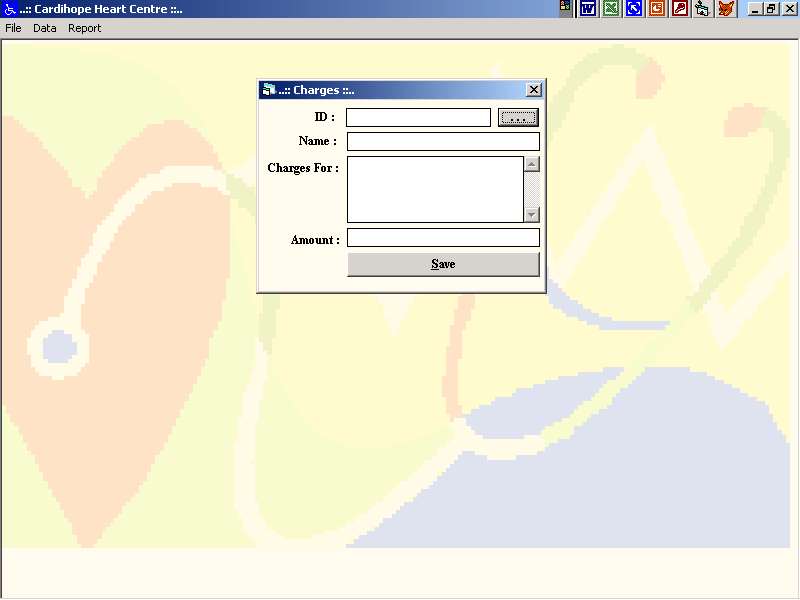
Module Name: mCommon.bas
Function Name: clearforms
Purpose: to clear each textbox present in the form

A. EVALUATION OF THE SOLUTION:
I have divided the different aspects in order to describe the evaluation of the implementation of the new system.
A.1 Evaluation in terms of the variety of data
Old system | New system |
| 1. In the manual system few data were present for example the due of patient fees were absent. So, the accountants had to wait until the end of the month to know that any patient is due to pay. This caused an overall degradation in the performance of the system and also caused the loss of income. As the patients who are due could not be found.
2. The accountants had to see the book to want the details about a certain patient because the patient ID did not reveal enough information about the patients.
3. The patient from whom payment is due is found by going through two books. This is a very a tough job. | 1. In the new system each and every item of data that are needed by the accountant are kept so that effortless running of the clinic’s finance management can be ensured. Having the due calculating facility enables the management to know the patients due payment and receive a print out of the due list. This saves up time, effort and money.
2. The patient code reveals all the required information about the patient: class, section and roll number. So, the management can easily know about the patient without any hassle.
3. Since the patient file and the fee collection files are linked, it takes no time to find out which patients are due for payment. |
A.2 Evaluation in terms of time taken to produce reports
Old system | New system |
| In the previous manual system few reports were produced. Moreover, it took a lot of time to produce them because the information required needed to be collected from different books. Also, the reports were not so dependable because the method of producing was an error prone way. For example, the expenditure list could not be produced perfectly because the little expenses in the maintenance were not recorded. | In the new system the reports are produced automatically after a regular period of work. The program collects information from different files and then puts them together to print the reports. This is a very fast and error free method. |
A.3 Evaluation in terms of the requirements for reports
System requirements | Outputs successfully produced |
| Money Receipt | YES |
| Payroll Report | YES |
| Discharged Patients | YES |
| Charges of the Patients | YES |
A.4 Evaluation in terms of the validity of data
Old system | New system |
| CALCULATED NUMERIC FIGURES: In the previous system all the calculations were done manually by a calculator and as seen in the systems analysis part there are a lot of calculations involved e.g. while calculating the money received for patients charges, total income and expenditure and also the calculation of rents, bills, etc. (as seen from the sample of present outputs). Hence the calculated results are very much prone to mistakes due to human errors.
INPUT DATA: In the former system there is no way other than visual checking to ensure the validity of input data. That is the accountants are never protected from entering wrong or invalid data. | CALCULATED NUMERIC FIGURES: In the implemented system the computer does all the calculations and the results are kept in the appropriate records. Therefore, there is no doubt of having mistakes in the calculations. Most importantly it does not require any interference from the user.
INPUT DATA: The system is developed in such a manner that entry of incorrect data during input is minimized. There are several error checks applied in the program to ensure the validity and authenticity of input data. |
A.5 Evaluation in terms of cost implications
The implemented system fits within the budget of the clinic thus making the implementation feasible. Though the initial cost is a bit higher it economizes on the number of labour required, negligible storage cost and mainly the benefits achieved from the system tend to overcome any problems with the cost. The other aspects in which the new system is better than the old system in terms of cost are stated in the parts ‘Evaluation in terms of labour resources and work required’ and ‘Evaluation in terms of storage space’. The running cost of the new system is also less than the old one since there is no need to buy registers and other stationary items
A.6 Evaluation in terms of labour resources & work required
Old system | New system |
2. The old system would employ an extra staff just for the maintenance of the books and recording of data to achieve efficiency and quality in the statements but also adding to the costs. | 1. The entries into several books following a transaction are all done automatically.
2. Only a computer literate employee i.e. the accountant who fairly knows about the system would be sufficient to manage all parts of the system. |
A.7 Evaluation in terms of storage space
Old system | New system |
| The old system required huge storage spaces to store bundles of books of various types and groups. | The computer hard disk is required to store all the data so there is no need of storage space. However only a drawer is sufficient to store disks containing backups of data. |
A.8 Evaluation in terms of searching for any information
Old system | New system |
| In the old system looking for particular book was tiresome and inefficient. The employees had to search books in cabins, then search for categories and there were also many other disadvantages involved. | The new system provides a complete solution to this problem of queries. The program has automated process to the solution of queries (this part is described in the user manual). |
A.9 Evaluation of the user interface
The interface is very user friendly and easy to comprehend. Error messages guide the user through the process follows every step. In case of user errors, clear error messages are displayed describing the cause of the error and allowing the user to rectify the errors. The message boxes provide an easy guide for a new user to cope with the system.
